Nursing Decision Making and Practice
VerifiedAdded on 2023/03/31
|10
|2084
|390
AI Summary
This document discusses the rationales for nursing interventions in a clinical case, focusing on topics such as ECG, vital signs measurement, oxygen administration, intravenous cannulation, pain management, cardiac monitoring, and more. It provides insights on effective nursing decision making and practice.
Contribute Materials
Your contribution can guide someone’s learning journey. Share your
documents today.
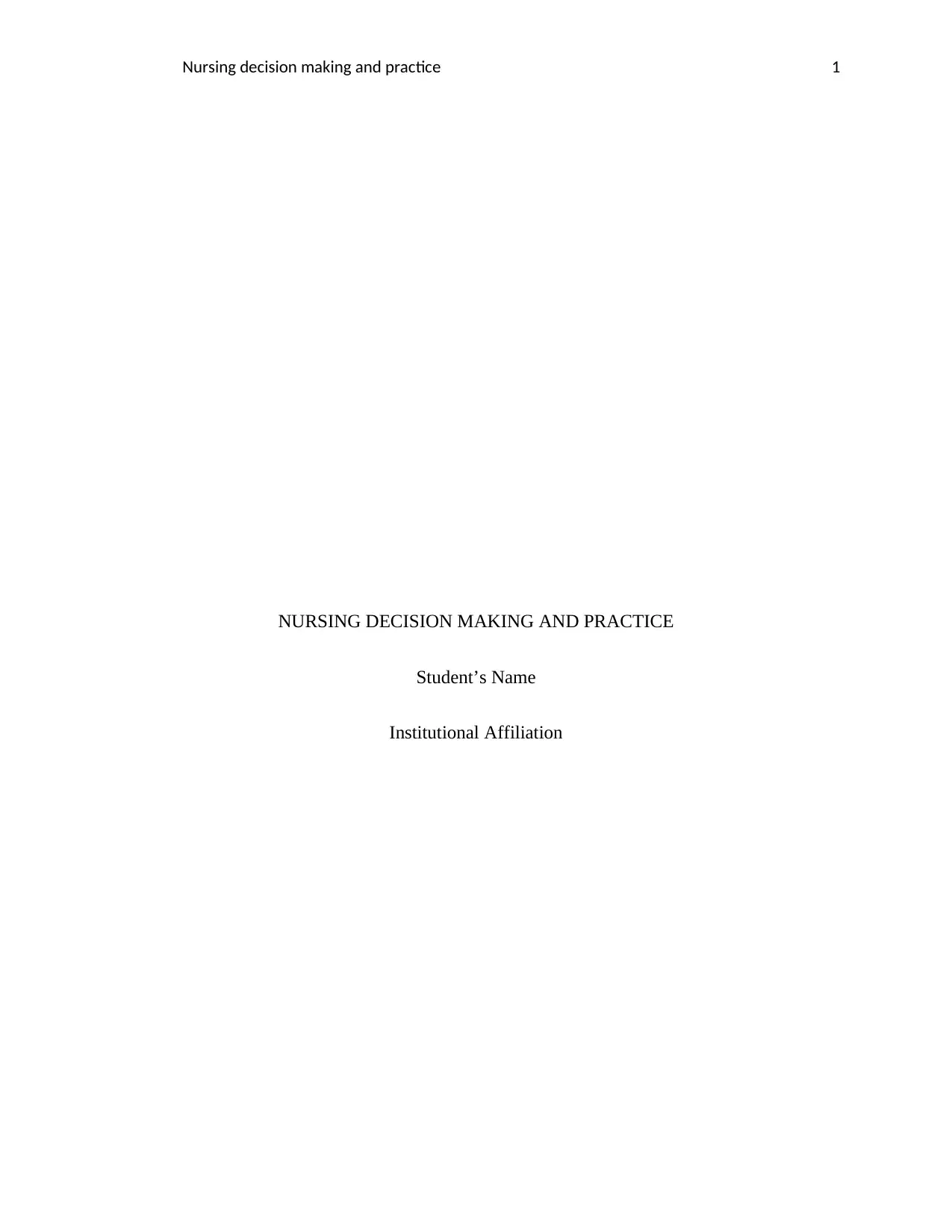
Nursing decision making and practice 1
NURSING DECISION MAKING AND PRACTICE
Student’s Name
Institutional Affiliation
NURSING DECISION MAKING AND PRACTICE
Student’s Name
Institutional Affiliation
Secure Best Marks with AI Grader
Need help grading? Try our AI Grader for instant feedback on your assignments.

Nursing decision making and practice 2
The following are the rationales for the nursing interventions that would be effective for
the clinical case of Mrs. Fitzgerald:
1. ECG (ELECTROCARDIOGRAM)
Rationale:
An electrocardiogram test is important in assessment and diagnosis of patients
with an acute coronary syndrome. It is an effective tool for detecting acute myocardial
infarction and assists in identifying the severity of a heart attack. It provides information
of the extent of myocardial tissue damage caused by a myocardial infarction. Elevation of
the T wave on performing an electrocardiogram on a patient indicates early ischemia
(Hart et al, 2015). The ST wave is an important marker of the various types of coronary
acute syndromes. Coronary acute syndromes include the ST-elevation myocardial
infarction, non ST-elevation myocardial infarction and unstable angina. These are major
causes of chest pains and an electrocardiogram performed on the patient under the case
study can assist the clinician make the appropriate diagnosis and treatment plan.
An ST segment elevation indicates total occlusion of a major coronary artery
leading to ischemia of a significant part of the myocardium (Waters, 2016). If not
corrected, the myocardial infarction can lead to ischemia and subsequent heart failure.
The ST-elevation myocardial infarction is indicated by an elevation of the ST segment is
greater than 2mm in two contiguous leads. The affected leads can guide the clinician to
the affected parts. On the other hand, a non ST-elevation myocardial infarction represents
a more mild form of acute myocardial infarction and is indicated by ECG recordings of
an ST segment depression in several contiguous leads. Jensen, (2018) states it occurs
The following are the rationales for the nursing interventions that would be effective for
the clinical case of Mrs. Fitzgerald:
1. ECG (ELECTROCARDIOGRAM)
Rationale:
An electrocardiogram test is important in assessment and diagnosis of patients
with an acute coronary syndrome. It is an effective tool for detecting acute myocardial
infarction and assists in identifying the severity of a heart attack. It provides information
of the extent of myocardial tissue damage caused by a myocardial infarction. Elevation of
the T wave on performing an electrocardiogram on a patient indicates early ischemia
(Hart et al, 2015). The ST wave is an important marker of the various types of coronary
acute syndromes. Coronary acute syndromes include the ST-elevation myocardial
infarction, non ST-elevation myocardial infarction and unstable angina. These are major
causes of chest pains and an electrocardiogram performed on the patient under the case
study can assist the clinician make the appropriate diagnosis and treatment plan.
An ST segment elevation indicates total occlusion of a major coronary artery
leading to ischemia of a significant part of the myocardium (Waters, 2016). If not
corrected, the myocardial infarction can lead to ischemia and subsequent heart failure.
The ST-elevation myocardial infarction is indicated by an elevation of the ST segment is
greater than 2mm in two contiguous leads. The affected leads can guide the clinician to
the affected parts. On the other hand, a non ST-elevation myocardial infarction represents
a more mild form of acute myocardial infarction and is indicated by ECG recordings of
an ST segment depression in several contiguous leads. Jensen, (2018) states it occurs
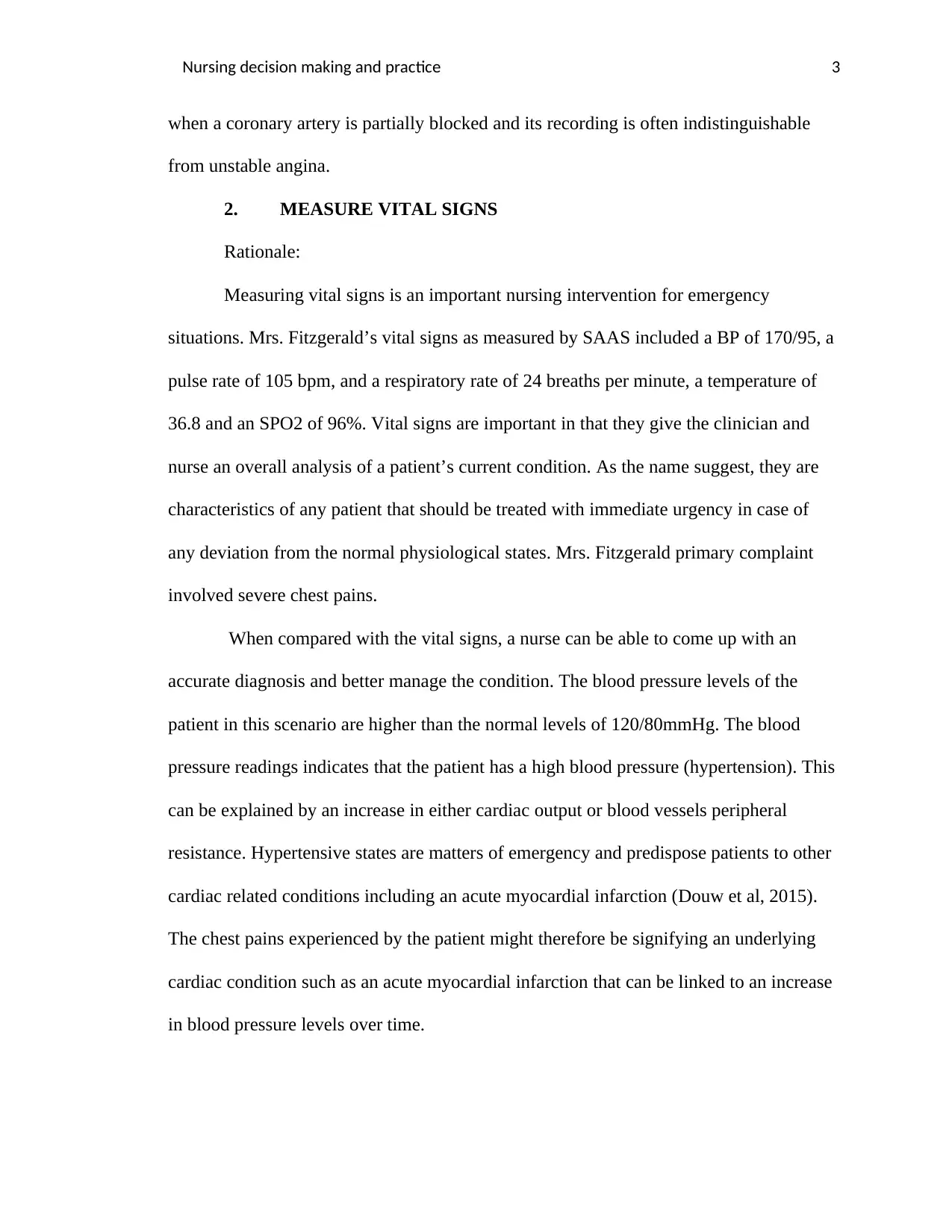
Nursing decision making and practice 3
when a coronary artery is partially blocked and its recording is often indistinguishable
from unstable angina.
2. MEASURE VITAL SIGNS
Rationale:
Measuring vital signs is an important nursing intervention for emergency
situations. Mrs. Fitzgerald’s vital signs as measured by SAAS included a BP of 170/95, a
pulse rate of 105 bpm, and a respiratory rate of 24 breaths per minute, a temperature of
36.8 and an SPO2 of 96%. Vital signs are important in that they give the clinician and
nurse an overall analysis of a patient’s current condition. As the name suggest, they are
characteristics of any patient that should be treated with immediate urgency in case of
any deviation from the normal physiological states. Mrs. Fitzgerald primary complaint
involved severe chest pains.
When compared with the vital signs, a nurse can be able to come up with an
accurate diagnosis and better manage the condition. The blood pressure levels of the
patient in this scenario are higher than the normal levels of 120/80mmHg. The blood
pressure readings indicates that the patient has a high blood pressure (hypertension). This
can be explained by an increase in either cardiac output or blood vessels peripheral
resistance. Hypertensive states are matters of emergency and predispose patients to other
cardiac related conditions including an acute myocardial infarction (Douw et al, 2015).
The chest pains experienced by the patient might therefore be signifying an underlying
cardiac condition such as an acute myocardial infarction that can be linked to an increase
in blood pressure levels over time.
when a coronary artery is partially blocked and its recording is often indistinguishable
from unstable angina.
2. MEASURE VITAL SIGNS
Rationale:
Measuring vital signs is an important nursing intervention for emergency
situations. Mrs. Fitzgerald’s vital signs as measured by SAAS included a BP of 170/95, a
pulse rate of 105 bpm, and a respiratory rate of 24 breaths per minute, a temperature of
36.8 and an SPO2 of 96%. Vital signs are important in that they give the clinician and
nurse an overall analysis of a patient’s current condition. As the name suggest, they are
characteristics of any patient that should be treated with immediate urgency in case of
any deviation from the normal physiological states. Mrs. Fitzgerald primary complaint
involved severe chest pains.
When compared with the vital signs, a nurse can be able to come up with an
accurate diagnosis and better manage the condition. The blood pressure levels of the
patient in this scenario are higher than the normal levels of 120/80mmHg. The blood
pressure readings indicates that the patient has a high blood pressure (hypertension). This
can be explained by an increase in either cardiac output or blood vessels peripheral
resistance. Hypertensive states are matters of emergency and predispose patients to other
cardiac related conditions including an acute myocardial infarction (Douw et al, 2015).
The chest pains experienced by the patient might therefore be signifying an underlying
cardiac condition such as an acute myocardial infarction that can be linked to an increase
in blood pressure levels over time.
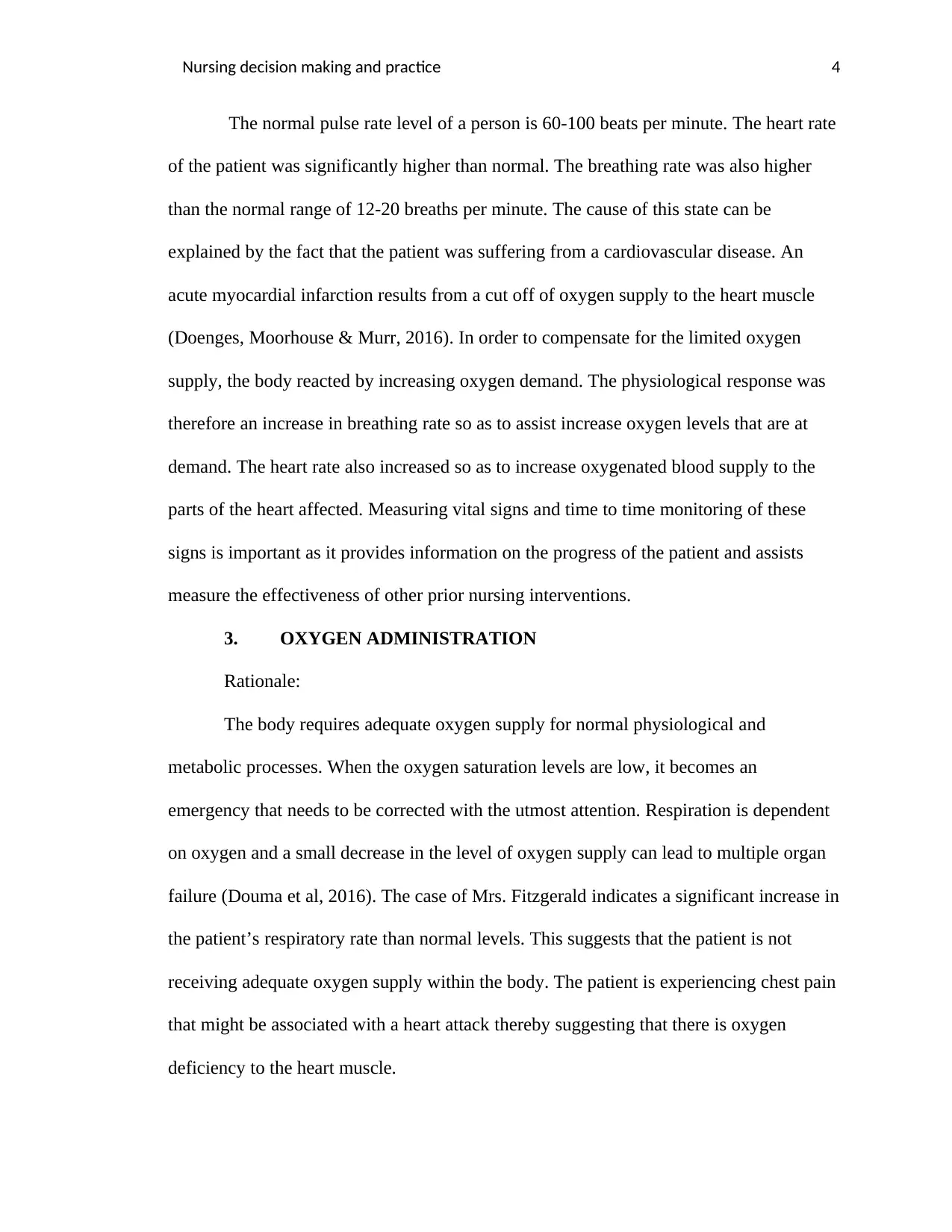
Nursing decision making and practice 4
The normal pulse rate level of a person is 60-100 beats per minute. The heart rate
of the patient was significantly higher than normal. The breathing rate was also higher
than the normal range of 12-20 breaths per minute. The cause of this state can be
explained by the fact that the patient was suffering from a cardiovascular disease. An
acute myocardial infarction results from a cut off of oxygen supply to the heart muscle
(Doenges, Moorhouse & Murr, 2016). In order to compensate for the limited oxygen
supply, the body reacted by increasing oxygen demand. The physiological response was
therefore an increase in breathing rate so as to assist increase oxygen levels that are at
demand. The heart rate also increased so as to increase oxygenated blood supply to the
parts of the heart affected. Measuring vital signs and time to time monitoring of these
signs is important as it provides information on the progress of the patient and assists
measure the effectiveness of other prior nursing interventions.
3. OXYGEN ADMINISTRATION
Rationale:
The body requires adequate oxygen supply for normal physiological and
metabolic processes. When the oxygen saturation levels are low, it becomes an
emergency that needs to be corrected with the utmost attention. Respiration is dependent
on oxygen and a small decrease in the level of oxygen supply can lead to multiple organ
failure (Douma et al, 2016). The case of Mrs. Fitzgerald indicates a significant increase in
the patient’s respiratory rate than normal levels. This suggests that the patient is not
receiving adequate oxygen supply within the body. The patient is experiencing chest pain
that might be associated with a heart attack thereby suggesting that there is oxygen
deficiency to the heart muscle.
The normal pulse rate level of a person is 60-100 beats per minute. The heart rate
of the patient was significantly higher than normal. The breathing rate was also higher
than the normal range of 12-20 breaths per minute. The cause of this state can be
explained by the fact that the patient was suffering from a cardiovascular disease. An
acute myocardial infarction results from a cut off of oxygen supply to the heart muscle
(Doenges, Moorhouse & Murr, 2016). In order to compensate for the limited oxygen
supply, the body reacted by increasing oxygen demand. The physiological response was
therefore an increase in breathing rate so as to assist increase oxygen levels that are at
demand. The heart rate also increased so as to increase oxygenated blood supply to the
parts of the heart affected. Measuring vital signs and time to time monitoring of these
signs is important as it provides information on the progress of the patient and assists
measure the effectiveness of other prior nursing interventions.
3. OXYGEN ADMINISTRATION
Rationale:
The body requires adequate oxygen supply for normal physiological and
metabolic processes. When the oxygen saturation levels are low, it becomes an
emergency that needs to be corrected with the utmost attention. Respiration is dependent
on oxygen and a small decrease in the level of oxygen supply can lead to multiple organ
failure (Douma et al, 2016). The case of Mrs. Fitzgerald indicates a significant increase in
the patient’s respiratory rate than normal levels. This suggests that the patient is not
receiving adequate oxygen supply within the body. The patient is experiencing chest pain
that might be associated with a heart attack thereby suggesting that there is oxygen
deficiency to the heart muscle.
Secure Best Marks with AI Grader
Need help grading? Try our AI Grader for instant feedback on your assignments.

Nursing decision making and practice 5
There is need to administer oxygen so as to boost the level of oxygen supply to
the heart muscle as well as other body tissues. This is an important step as it helps
alleviate the symptoms of chest pain caused by limited oxygen supply to the heart
muscle. In addition to this, inadequate oxygen supply can lead to necrosis and an eventual
heart failure which is fatal. There is therefore need to administer enough oxygen to
prevent worse outcomes. Measurement of SPO2 levels is important to detect the level of
oxygen saturation in the body as well as how much oxygen levels should be administered
to alleviate hypoxic states (Tang, 2018). An SPO2 of less than 95% is alarming and
should be managed with administration of oxygen for longer periods.
4. PERFORM INTRAVENOUS CANNULATION
Rationale:
Intravenous cannulation is an important nursing intervention that involves
connecting a tube to a patient’s vein so that infusions can be inserted directly into the
patient’s bloodstream (Sanders, 2017). In this clinical case, this can be used to provide
medication that require intravenous route of administration. Intravenous nitroglycerin is
an example of a medication that can be administered to patients with an acute myocardial
infarction. Intravenous cannulation can also be used for administration of fluids to
patients with low blood volume. In this case, the patient can be assessed for signs of
dehydration and isotonic fluids administered to increase blood volume.
5. PAIN MANAGEMENT
Rationale:
The patient under study was suffering from pain. On being asked to rate the pain
she was experiencing, she stated it was a 7/10. This indicates the pain was severe and
There is need to administer oxygen so as to boost the level of oxygen supply to
the heart muscle as well as other body tissues. This is an important step as it helps
alleviate the symptoms of chest pain caused by limited oxygen supply to the heart
muscle. In addition to this, inadequate oxygen supply can lead to necrosis and an eventual
heart failure which is fatal. There is therefore need to administer enough oxygen to
prevent worse outcomes. Measurement of SPO2 levels is important to detect the level of
oxygen saturation in the body as well as how much oxygen levels should be administered
to alleviate hypoxic states (Tang, 2018). An SPO2 of less than 95% is alarming and
should be managed with administration of oxygen for longer periods.
4. PERFORM INTRAVENOUS CANNULATION
Rationale:
Intravenous cannulation is an important nursing intervention that involves
connecting a tube to a patient’s vein so that infusions can be inserted directly into the
patient’s bloodstream (Sanders, 2017). In this clinical case, this can be used to provide
medication that require intravenous route of administration. Intravenous nitroglycerin is
an example of a medication that can be administered to patients with an acute myocardial
infarction. Intravenous cannulation can also be used for administration of fluids to
patients with low blood volume. In this case, the patient can be assessed for signs of
dehydration and isotonic fluids administered to increase blood volume.
5. PAIN MANAGEMENT
Rationale:
The patient under study was suffering from pain. On being asked to rate the pain
she was experiencing, she stated it was a 7/10. This indicates the pain was severe and
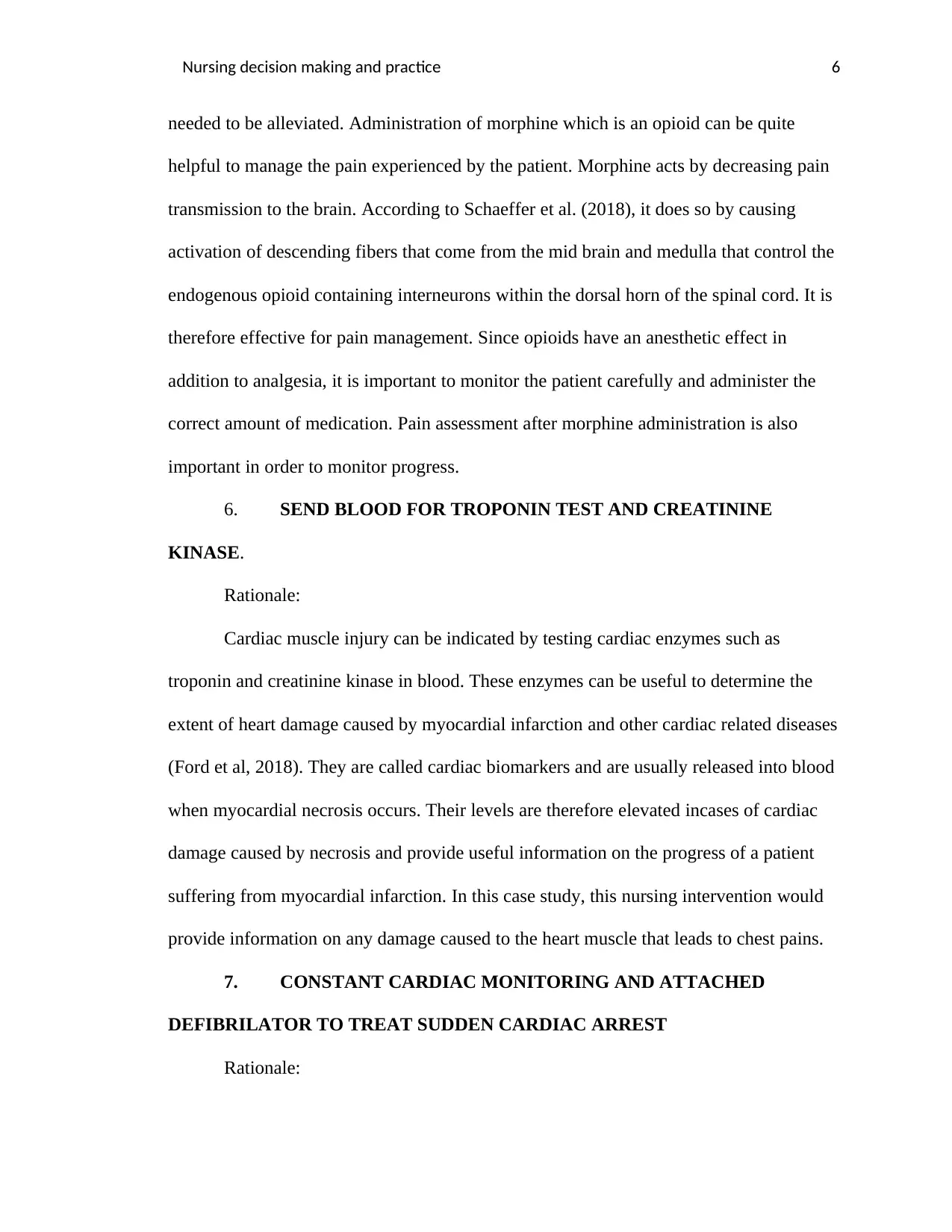
Nursing decision making and practice 6
needed to be alleviated. Administration of morphine which is an opioid can be quite
helpful to manage the pain experienced by the patient. Morphine acts by decreasing pain
transmission to the brain. According to Schaeffer et al. (2018), it does so by causing
activation of descending fibers that come from the mid brain and medulla that control the
endogenous opioid containing interneurons within the dorsal horn of the spinal cord. It is
therefore effective for pain management. Since opioids have an anesthetic effect in
addition to analgesia, it is important to monitor the patient carefully and administer the
correct amount of medication. Pain assessment after morphine administration is also
important in order to monitor progress.
6. SEND BLOOD FOR TROPONIN TEST AND CREATININE
KINASE.
Rationale:
Cardiac muscle injury can be indicated by testing cardiac enzymes such as
troponin and creatinine kinase in blood. These enzymes can be useful to determine the
extent of heart damage caused by myocardial infarction and other cardiac related diseases
(Ford et al, 2018). They are called cardiac biomarkers and are usually released into blood
when myocardial necrosis occurs. Their levels are therefore elevated incases of cardiac
damage caused by necrosis and provide useful information on the progress of a patient
suffering from myocardial infarction. In this case study, this nursing intervention would
provide information on any damage caused to the heart muscle that leads to chest pains.
7. CONSTANT CARDIAC MONITORING AND ATTACHED
DEFIBRILATOR TO TREAT SUDDEN CARDIAC ARREST
Rationale:
needed to be alleviated. Administration of morphine which is an opioid can be quite
helpful to manage the pain experienced by the patient. Morphine acts by decreasing pain
transmission to the brain. According to Schaeffer et al. (2018), it does so by causing
activation of descending fibers that come from the mid brain and medulla that control the
endogenous opioid containing interneurons within the dorsal horn of the spinal cord. It is
therefore effective for pain management. Since opioids have an anesthetic effect in
addition to analgesia, it is important to monitor the patient carefully and administer the
correct amount of medication. Pain assessment after morphine administration is also
important in order to monitor progress.
6. SEND BLOOD FOR TROPONIN TEST AND CREATININE
KINASE.
Rationale:
Cardiac muscle injury can be indicated by testing cardiac enzymes such as
troponin and creatinine kinase in blood. These enzymes can be useful to determine the
extent of heart damage caused by myocardial infarction and other cardiac related diseases
(Ford et al, 2018). They are called cardiac biomarkers and are usually released into blood
when myocardial necrosis occurs. Their levels are therefore elevated incases of cardiac
damage caused by necrosis and provide useful information on the progress of a patient
suffering from myocardial infarction. In this case study, this nursing intervention would
provide information on any damage caused to the heart muscle that leads to chest pains.
7. CONSTANT CARDIAC MONITORING AND ATTACHED
DEFIBRILATOR TO TREAT SUDDEN CARDIAC ARREST
Rationale:
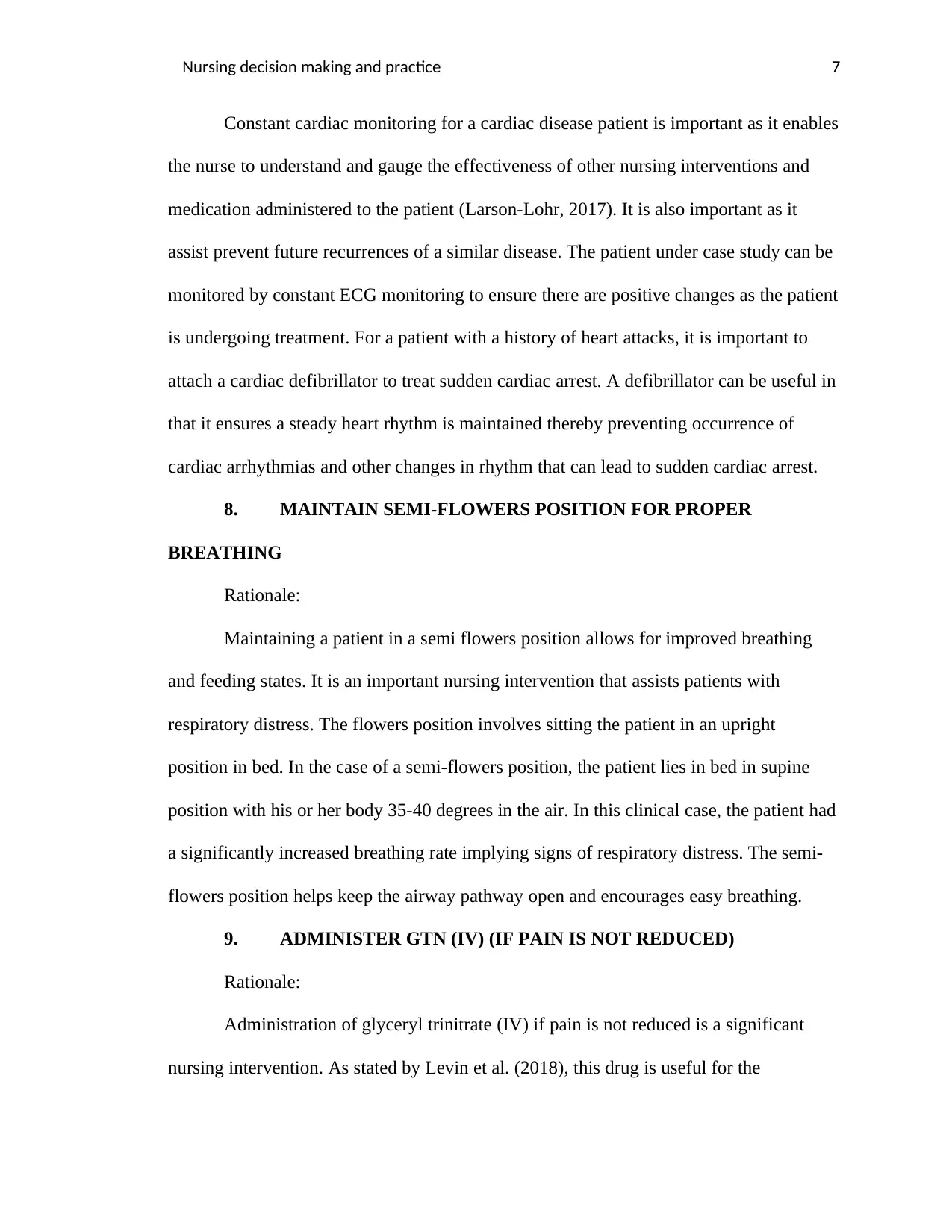
Nursing decision making and practice 7
Constant cardiac monitoring for a cardiac disease patient is important as it enables
the nurse to understand and gauge the effectiveness of other nursing interventions and
medication administered to the patient (Larson-Lohr, 2017). It is also important as it
assist prevent future recurrences of a similar disease. The patient under case study can be
monitored by constant ECG monitoring to ensure there are positive changes as the patient
is undergoing treatment. For a patient with a history of heart attacks, it is important to
attach a cardiac defibrillator to treat sudden cardiac arrest. A defibrillator can be useful in
that it ensures a steady heart rhythm is maintained thereby preventing occurrence of
cardiac arrhythmias and other changes in rhythm that can lead to sudden cardiac arrest.
8. MAINTAIN SEMI-FLOWERS POSITION FOR PROPER
BREATHING
Rationale:
Maintaining a patient in a semi flowers position allows for improved breathing
and feeding states. It is an important nursing intervention that assists patients with
respiratory distress. The flowers position involves sitting the patient in an upright
position in bed. In the case of a semi-flowers position, the patient lies in bed in supine
position with his or her body 35-40 degrees in the air. In this clinical case, the patient had
a significantly increased breathing rate implying signs of respiratory distress. The semi-
flowers position helps keep the airway pathway open and encourages easy breathing.
9. ADMINISTER GTN (IV) (IF PAIN IS NOT REDUCED)
Rationale:
Administration of glyceryl trinitrate (IV) if pain is not reduced is a significant
nursing intervention. As stated by Levin et al. (2018), this drug is useful for the
Constant cardiac monitoring for a cardiac disease patient is important as it enables
the nurse to understand and gauge the effectiveness of other nursing interventions and
medication administered to the patient (Larson-Lohr, 2017). It is also important as it
assist prevent future recurrences of a similar disease. The patient under case study can be
monitored by constant ECG monitoring to ensure there are positive changes as the patient
is undergoing treatment. For a patient with a history of heart attacks, it is important to
attach a cardiac defibrillator to treat sudden cardiac arrest. A defibrillator can be useful in
that it ensures a steady heart rhythm is maintained thereby preventing occurrence of
cardiac arrhythmias and other changes in rhythm that can lead to sudden cardiac arrest.
8. MAINTAIN SEMI-FLOWERS POSITION FOR PROPER
BREATHING
Rationale:
Maintaining a patient in a semi flowers position allows for improved breathing
and feeding states. It is an important nursing intervention that assists patients with
respiratory distress. The flowers position involves sitting the patient in an upright
position in bed. In the case of a semi-flowers position, the patient lies in bed in supine
position with his or her body 35-40 degrees in the air. In this clinical case, the patient had
a significantly increased breathing rate implying signs of respiratory distress. The semi-
flowers position helps keep the airway pathway open and encourages easy breathing.
9. ADMINISTER GTN (IV) (IF PAIN IS NOT REDUCED)
Rationale:
Administration of glyceryl trinitrate (IV) if pain is not reduced is a significant
nursing intervention. As stated by Levin et al. (2018), this drug is useful for the
Paraphrase This Document
Need a fresh take? Get an instant paraphrase of this document with our AI Paraphraser

Nursing decision making and practice 8
management of heart failure, hypertension and is used to treat chest pains that result from
inadequate blood flow to the heart as in the case of angina. It therefore has multiple
effects that help manage pain caused by cardiac related problems. As opposed to
morphine which is analgesic GTN (IV) targets the various underlying pathologies of a
heart attack.
management of heart failure, hypertension and is used to treat chest pains that result from
inadequate blood flow to the heart as in the case of angina. It therefore has multiple
effects that help manage pain caused by cardiac related problems. As opposed to
morphine which is analgesic GTN (IV) targets the various underlying pathologies of a
heart attack.
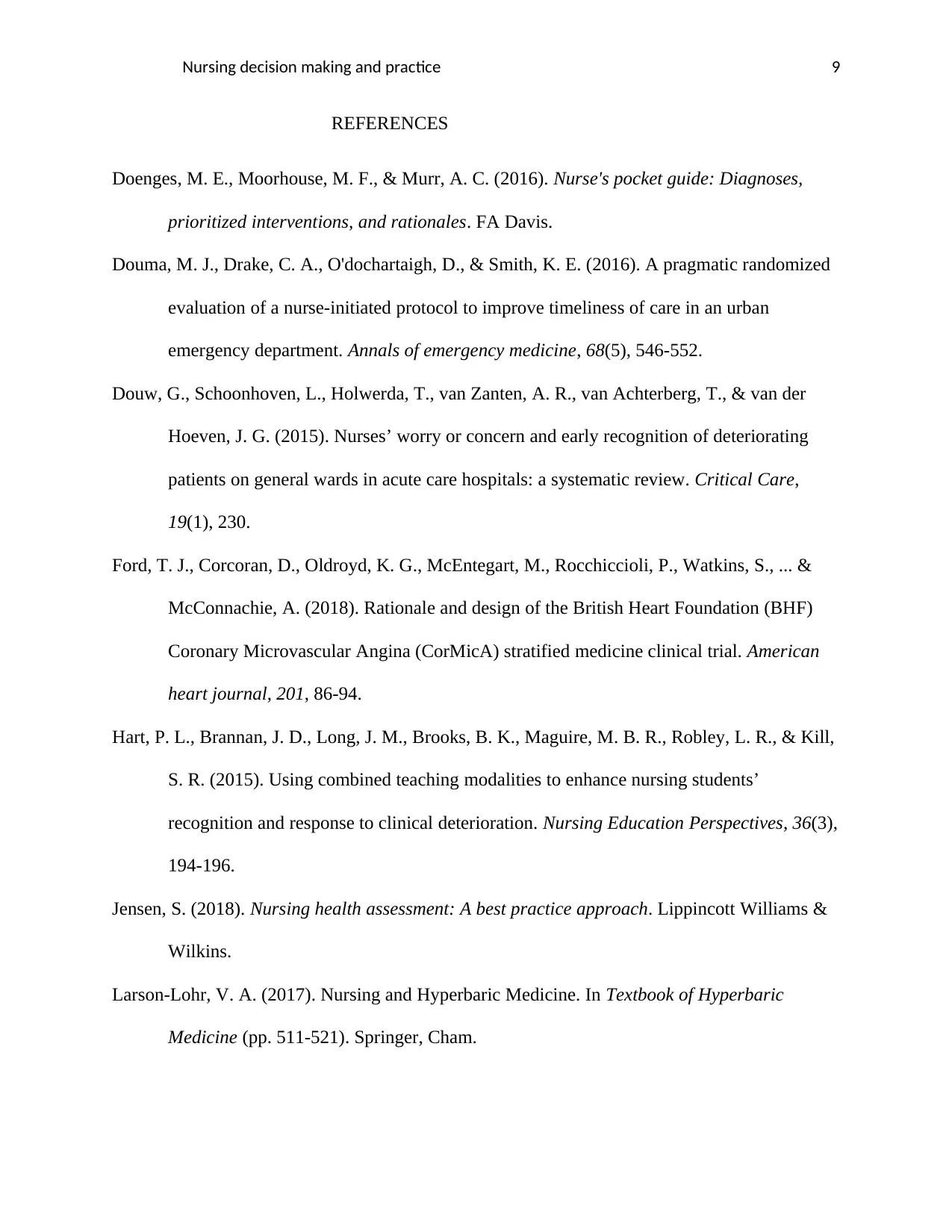
Nursing decision making and practice 9
REFERENCES
Doenges, M. E., Moorhouse, M. F., & Murr, A. C. (2016). Nurse's pocket guide: Diagnoses,
prioritized interventions, and rationales. FA Davis.
Douma, M. J., Drake, C. A., O'dochartaigh, D., & Smith, K. E. (2016). A pragmatic randomized
evaluation of a nurse-initiated protocol to improve timeliness of care in an urban
emergency department. Annals of emergency medicine, 68(5), 546-552.
Douw, G., Schoonhoven, L., Holwerda, T., van Zanten, A. R., van Achterberg, T., & van der
Hoeven, J. G. (2015). Nurses’ worry or concern and early recognition of deteriorating
patients on general wards in acute care hospitals: a systematic review. Critical Care,
19(1), 230.
Ford, T. J., Corcoran, D., Oldroyd, K. G., McEntegart, M., Rocchiccioli, P., Watkins, S., ... &
McConnachie, A. (2018). Rationale and design of the British Heart Foundation (BHF)
Coronary Microvascular Angina (CorMicA) stratified medicine clinical trial. American
heart journal, 201, 86-94.
Hart, P. L., Brannan, J. D., Long, J. M., Brooks, B. K., Maguire, M. B. R., Robley, L. R., & Kill,
S. R. (2015). Using combined teaching modalities to enhance nursing students’
recognition and response to clinical deterioration. Nursing Education Perspectives, 36(3),
194-196.
Jensen, S. (2018). Nursing health assessment: A best practice approach. Lippincott Williams &
Wilkins.
Larson-Lohr, V. A. (2017). Nursing and Hyperbaric Medicine. In Textbook of Hyperbaric
Medicine (pp. 511-521). Springer, Cham.
REFERENCES
Doenges, M. E., Moorhouse, M. F., & Murr, A. C. (2016). Nurse's pocket guide: Diagnoses,
prioritized interventions, and rationales. FA Davis.
Douma, M. J., Drake, C. A., O'dochartaigh, D., & Smith, K. E. (2016). A pragmatic randomized
evaluation of a nurse-initiated protocol to improve timeliness of care in an urban
emergency department. Annals of emergency medicine, 68(5), 546-552.
Douw, G., Schoonhoven, L., Holwerda, T., van Zanten, A. R., van Achterberg, T., & van der
Hoeven, J. G. (2015). Nurses’ worry or concern and early recognition of deteriorating
patients on general wards in acute care hospitals: a systematic review. Critical Care,
19(1), 230.
Ford, T. J., Corcoran, D., Oldroyd, K. G., McEntegart, M., Rocchiccioli, P., Watkins, S., ... &
McConnachie, A. (2018). Rationale and design of the British Heart Foundation (BHF)
Coronary Microvascular Angina (CorMicA) stratified medicine clinical trial. American
heart journal, 201, 86-94.
Hart, P. L., Brannan, J. D., Long, J. M., Brooks, B. K., Maguire, M. B. R., Robley, L. R., & Kill,
S. R. (2015). Using combined teaching modalities to enhance nursing students’
recognition and response to clinical deterioration. Nursing Education Perspectives, 36(3),
194-196.
Jensen, S. (2018). Nursing health assessment: A best practice approach. Lippincott Williams &
Wilkins.
Larson-Lohr, V. A. (2017). Nursing and Hyperbaric Medicine. In Textbook of Hyperbaric
Medicine (pp. 511-521). Springer, Cham.
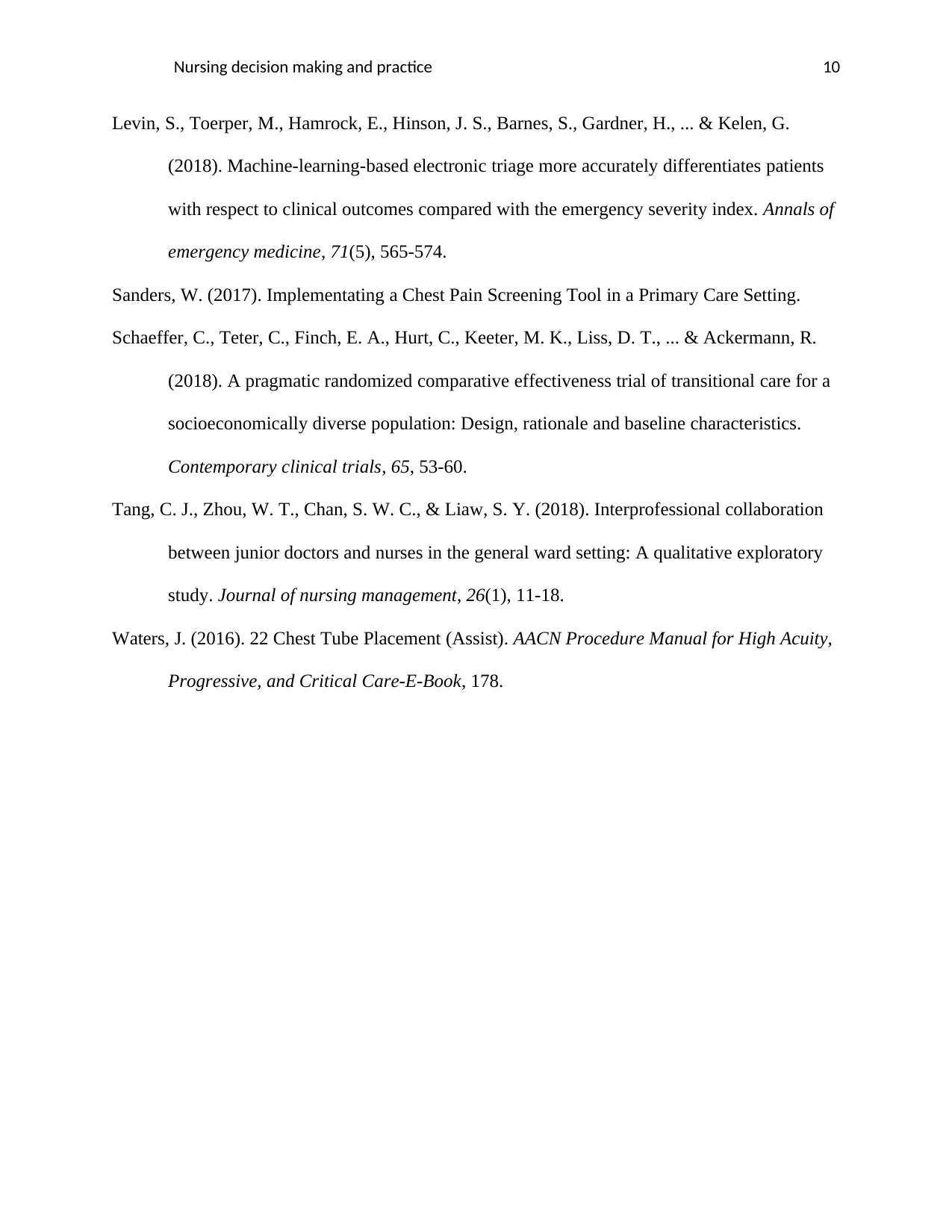
Nursing decision making and practice 10
Levin, S., Toerper, M., Hamrock, E., Hinson, J. S., Barnes, S., Gardner, H., ... & Kelen, G.
(2018). Machine-learning-based electronic triage more accurately differentiates patients
with respect to clinical outcomes compared with the emergency severity index. Annals of
emergency medicine, 71(5), 565-574.
Sanders, W. (2017). Implementating a Chest Pain Screening Tool in a Primary Care Setting.
Schaeffer, C., Teter, C., Finch, E. A., Hurt, C., Keeter, M. K., Liss, D. T., ... & Ackermann, R.
(2018). A pragmatic randomized comparative effectiveness trial of transitional care for a
socioeconomically diverse population: Design, rationale and baseline characteristics.
Contemporary clinical trials, 65, 53-60.
Tang, C. J., Zhou, W. T., Chan, S. W. C., & Liaw, S. Y. (2018). Interprofessional collaboration
between junior doctors and nurses in the general ward setting: A qualitative exploratory
study. Journal of nursing management, 26(1), 11-18.
Waters, J. (2016). 22 Chest Tube Placement (Assist). AACN Procedure Manual for High Acuity,
Progressive, and Critical Care-E-Book, 178.
Levin, S., Toerper, M., Hamrock, E., Hinson, J. S., Barnes, S., Gardner, H., ... & Kelen, G.
(2018). Machine-learning-based electronic triage more accurately differentiates patients
with respect to clinical outcomes compared with the emergency severity index. Annals of
emergency medicine, 71(5), 565-574.
Sanders, W. (2017). Implementating a Chest Pain Screening Tool in a Primary Care Setting.
Schaeffer, C., Teter, C., Finch, E. A., Hurt, C., Keeter, M. K., Liss, D. T., ... & Ackermann, R.
(2018). A pragmatic randomized comparative effectiveness trial of transitional care for a
socioeconomically diverse population: Design, rationale and baseline characteristics.
Contemporary clinical trials, 65, 53-60.
Tang, C. J., Zhou, W. T., Chan, S. W. C., & Liaw, S. Y. (2018). Interprofessional collaboration
between junior doctors and nurses in the general ward setting: A qualitative exploratory
study. Journal of nursing management, 26(1), 11-18.
Waters, J. (2016). 22 Chest Tube Placement (Assist). AACN Procedure Manual for High Acuity,
Progressive, and Critical Care-E-Book, 178.
1 out of 10
![[object Object]](/_next/static/media/star-bottom.7253800d.svg)





